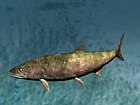
The Amiiformes order of fish has only two extant species, the bowfins: Amia calva and Amia ocellicauda, the latter recognized as a separate species in 2022. These Amiiformes are found in the freshwater systems of North America, in the United States and parts of southern Canada. They live in freshwater streams, rivers, and swamps. The order first appeared in the Triassic, and the extinct members include both marine and freshwater species, many of which are morphologically disparate from bowfins, such as the caturids.
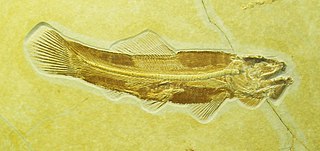
The Amiidae are a family of basal ray-finned fishes. The bowfin and the eyespot bowfin are the only two species to survive today, although additional species in all four subfamilies of Amiidae are known from Jurassic, Cretaceous, and Eocene fossils.

Hybodus is an extinct genus of hybodont that lived from the Middle Triassic to the Late Cretaceous periods. Species closely related to the type species Hybodus reticulatus lived during the Early Jurassic epoch. Numerous species have been assigned to Hybodus spanning a large period of time, and it is currently considered a wastebasket taxon that is 'broadly polyphyletic' and requires reexamination.
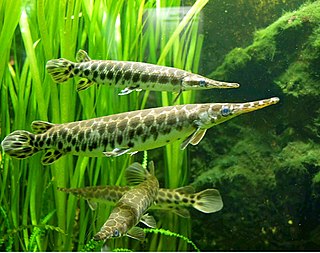
Lepisosteiformes is an order of ray-finned fish and the only living members of the clade Ginglymodi. Its only extant representatives are the gar, and it is defined as all members of Ginglymodi that are more closely related to gar than to the extinct Semionotiformes, the other major grouping of ginglymodians. They are one of two extant orders in the infraclass Holostei alongside the Amiiformes.
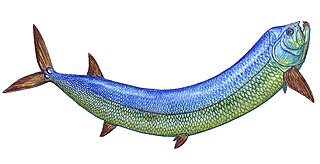
Cooyoo is an extinct genus of ichthyodectid ray-finned fish known from the Lower Cretaceous. It contains a single species, C. australis, known from the Albian-aged Toolebuc and Allaru Formations of Queensland, Australia. C. australis was originally named by Arthur Smith Woodward as a species of Portheus in 1894, which was later amended to Xiphactinus.
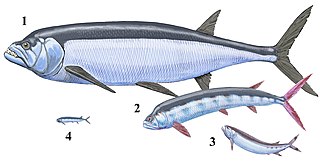
Ichthyodectiformes is an extinct order of marine stem-teleost ray-finned fish. The order is named after the genus Ichthyodectes, established by Edward Drinker Cope in 1870. Ichthyodectiforms are usually considered to be some of the closest relatives of the teleost crown group.

Axelrodichthys is an extinct genus of mawsoniid coelacanth from the Cretaceous of Africa, North and South America, and Europe. Several species are known, the remains of which were discovered in the Lower Cretaceous (Aptian-Albian) of Brazil, North Africa, and possibly Mexico, as well as in the Upper Cretaceous of Morocco (Cenomanian), Madagascar and France. The Axelrodichthys of the Lower Cretaceous frequented both brackish and coastal marine waters while the most recent species lived exclusively in fresh waters. The French specimens are the last known fresh water coelacanths. Most of the species of this genus reached 1 metre to 2 metres in length. Axelrodichthys was named in 1986 by John G. Maisey in honor of the American ichthyologist Herbert R. Axelrod.

Mawsonia is an extinct genus of prehistoric coelacanth fish. It is amongst the largest of all coelacanths, with one quadrate specimen possibly belonging to an individual measuring 5.3 metres in length. It lived in freshwater and brackish environments from the late Jurassic to the mid-Cretaceous of South America, eastern North America, and Africa. Mawsonia was first described by British paleontologist Arthur Smith Woodward in 1907.
Ferganoceratodus is a genus of prehistoric lungfish known from the Mesozoic of Asia and Africa. Based on morphological evidence, it has either been recovered as a basal member of the Ceratodontiformes or to be the sister group of the Neoceratodontidae.

The Sao Khua Formation is a middle member of the Khorat Group. It consists of an alteration of pale red to yellowish-gray, fine to medium-grained sandstone and grayish-reddish brown siltstone and clay. Rare pale red to light gray conglomerates, containing carbonate pebbles, are also characteristic of this formation. This geological formation in Thailand dates to the Early Cretaceous age, specifically the Valanginian through Hauterivian stages.

Araripichthys is an extinct genus of marine ray-finned fish that lived from the Aptian to Coniacian stages of the Cretaceous period. The genus is named after the Araripe Basin, where it was found in the Crato and Santana Formations. Other fossils of the genus have been found at Goulmima in Morocco, the Tlayua Formation of Mexico and the Apón Formation of Venezuela.
Stromerichthys is an extinct genus of potentially chimaeric freshwater bony fish that lived during the Late Cretaceous epoch. It contains a single species, S. aethiopicus, described from a now-lost specimen with bones & scales from Egypt.
Mioceratodus is an extinct genus of lungfish in the family Neoceratodontidae, which also contains the extant Queensland lungfish. It is known only from Oligocene and Miocene-aged sediments in Australia, although phylogenetic evidence supports it having first diverged from its closest relative, Neoceratodus, during the Late Jurassic or Early Cretaceous period.
Martinichthys is an extinct genus of plethodid fish from the Cretaceous of North America. It is known from the Niobrara Chalk, in which it is exceedingly rare. It is named after one H. T. Martin, who collected the most complete specimen at the time of description.

The Early Cretaceous Phu Kradung Formation is the lowest member of the Mesozoic Khorat Group which outcrops on the Khorat Plateau in Isan, Thailand. This geological formation consists of micaceous, brown to reddish-brown siltstone beds with minor brown and grey shale and sandstone beds. Occasional lime-noduled conglomerate occurs.
The Khok Kruat Formation is a rock formation found in northeastern Thailand. It is the uppermost formation of the Khorat Group. It is dated to the Aptian stage of the Early Cretaceous period, and is notable for its fossils of dinosaurs. It is equivalent to the Gres superieurs Formation of Laos. The group is a fluvial formation consisting primarily of red siltstones and sandstones.
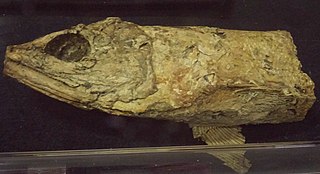
Goulmimichthys is an extinct genus of ray-finned fishes in the family Pachyrhizodontidae. The genus, first described by Cavin in 1995, is known from various Turonian age formations. The type species G. arambourgi from the Akrabou Formation in the El Rachidia Province of Morocco, and other fossils described are G. gasparini of the La Frontera Formation, Colombia, and G. roberti from the Agua Nueva Formation of Mexico.

Sinamiidae is an extinct family of ray-finned fish. They are halecomorph fishes endemic to Early Cretaceous freshwater environments in East and Southeast Asia.
Varavudh Suteethorn, or Warawut Suteethorn is a Thai palaeontologist and geologist. He is the current director of the Palaeontological Research and Education Centre, Mahasarakham University. He is best known for his work on vertebrate paleontology in northeastern Thailand, having contributed to the discovery of many fossil taxa and dig sites in the Khorat Plateau, as a part of a long-standing collaboration between Thai and French scientists.

Ginglymodi is a clade of ray-finned fish containing modern-day gars (Lepisosteidae) and their extinct relatives in the order Lepisosteiformes, the extinct orders Semionotiformes and Kyphosichthyiformes, and various other extinct taxa. Ginglymodi is one of the two major subgroups of the infraclass Holostei, the other one being Halecomorphi, which contains the bowfin and eyespot bowfin and their fossil relatives.














